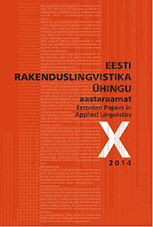Sõnaliigid eesti lapse kõnes ja lapsele suunatud kõnes
WORD CLASSES IN THE CHILD’S SPEECH AND IN THE CHILD-DIRECTED SPEECH
Author(s): Reili Argus, Helen KõrgesaarSubject(s): Language and Literature Studies
Published by: Eesti Rakenduslingvistika Ühing (ERÜ)
Keywords: first language acquisition; word classes; child-directed speech; child’s speech; Estonian
Summary/Abstract: This paper discusses the early phases of the acquisition of Estonian. The longitudinal data (recordings of spontaneous speech, 16 hours) of two Estonian typicallydeveloping monolingual children aged 1;3–2;3 and their caregivers was analyzed and compared in relation to frequency and distribution of different word classes and complexity of verbs. The main aim is to specify how this distribution changes when the child gets older and what kind of effect has the usage of verbs with different structure in the input to the child language. Distributional information about the occurrence of different word classes shows that in the beginning of the observation period the nouns were the most frequently used word class in children’s speech. At the same time, the speech of adults consists of approximately same amount of nouns and verbs. The frequency of usage of different word classes increases during the observation period: in the middle of their third year of life children start to use more verbs, adverbs, conjunctions, adjectives and adpositions, while the usage of verbs and adverbs increases remarkably during the observation period. The distribution of different word classes in the input does not change significantly during the observation period. Still the usage of verbs with different complexity (root verbs, derivated verbs, phrasal verbs and serial verb constructions) increases in the speech of adults and this reflects also in the speech of children. At the end of the observation period more verbs with complex structure (derivated verbs and phrasal verbs) were used by both children and the bigger usage of phrasal verbs by one adult can be considered to be reflecting also in the speech of the child.
Journal: Eesti Rakenduslingvistika Ühingu aastaraamat
- Issue Year: 2014
- Issue No: 10
- Page Range: 037-053
- Page Count: 17
- Language: Estonian

